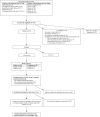A national recruitment strategy for HIV-serodiscordant partners living in Canada for the Positive Plus One study: a mixed-methods study
- PMID: 35473617
- PMCID: PMC9040331
- DOI: 10.1186/s12889-022-13153-5
A national recruitment strategy for HIV-serodiscordant partners living in Canada for the Positive Plus One study: a mixed-methods study
Abstract
Background: With the recent shift in focus to addressing HIV risk within relationships and couple-based interventions to prevent HIV transmission, successful recruitment of individuals involved in HIV-serodiscordant relationships is crucial. This paper evaluates methods used by the Positive Plus One (PP1) study to recruit and collect data on a diverse national sample of dyads and individuals involved in current or past HIV-serodiscordant relationships, discusses the strengths and limitations of the recruitment approach, and makes recommendations to inform the interpretation of study results and the design of future studies.
Methods: PP1 used a multi-pronged approach to recruit adults involved in a current or past HIV-serodiscordant relationship in Canada from 2016 to 2018 to complete a survey and an interview. Upon survey completion, index (first recruited) partners were invited to recruit their primary current HIV-serodiscordant partner. We investigated participant enrollment by recruitment source, participant-, relationship-, and dyad-level sociodemographic characteristics, missing data, and correlates of participation for individuals recruited by their partners.
Results: We recruited 613 participants (355 HIV-positive; 258 HIV-negative) across 10 Canadian provinces, including 153 complete dyads and 307 individuals who participated alone, and representing 460 HIV-serodiscordant relationships. Among those in current relationships, HIV-positive participants were more likely than HIV-negative participants to learn of the study through an ASO staff member (36% v. 20%, p < 0.001), ASO listserv/newsletter (12% v. 5%, p = 0.007), or physician/staff at a clinic (20% v. 11%, p = 0.006). HIV-negative participants involved in current relationships were more likely than HIV-positive participants to learn of the study through their partner (46% v. 8%, p < 0.001). Seventy-eight percent of index participants invited their primary HIV-serodiscordant partner to participate, and 40% were successful. Successful recruitment of primary partners was associated with longer relationship duration, higher relationship satisfaction, and a virally suppressed HIV-positive partner.
Conclusions: Our findings provide important new information on and support the use of a multi-pronged approach to recruit HIV-positive and HIV-negative individuals involved in HIV-serodiscordant relationships in Canada. More creative strategies are needed to help index partners recruit their partner in relationships with lower satisfaction and shorter duration and further minimize the risk of "happy couple" bias.
Keywords: Canada; Dyad; HIV; HIV-serodiscordant couple; Recruitment; Study design; Study method.
© 2022. The Author(s).
Conflict of interest statement
DHST has received investigator-initiated research grants from Abbvie, Gilead Sciences, and ViiV Healthcare, and is a Site Principal Investigator for clinical trials sponsored by Glaxo Smith Kline. BL received grants for investigator-initiated studies from ViiV Healthcare, Merck, and Gilead; consulting fees from ViiV Healthcare, Merck, and Gilead. All the other authors have no competing interests.
Figures
References
-
- Public Health Agency of Canada . Estimates of HIV incidence, prevalence and Canada’s progress on meeting the 90–90-90 HIV targets, 2018. 2020.
Publication types
MeSH terms
LinkOut - more resources
Full Text Sources
Medical
Miscellaneous


